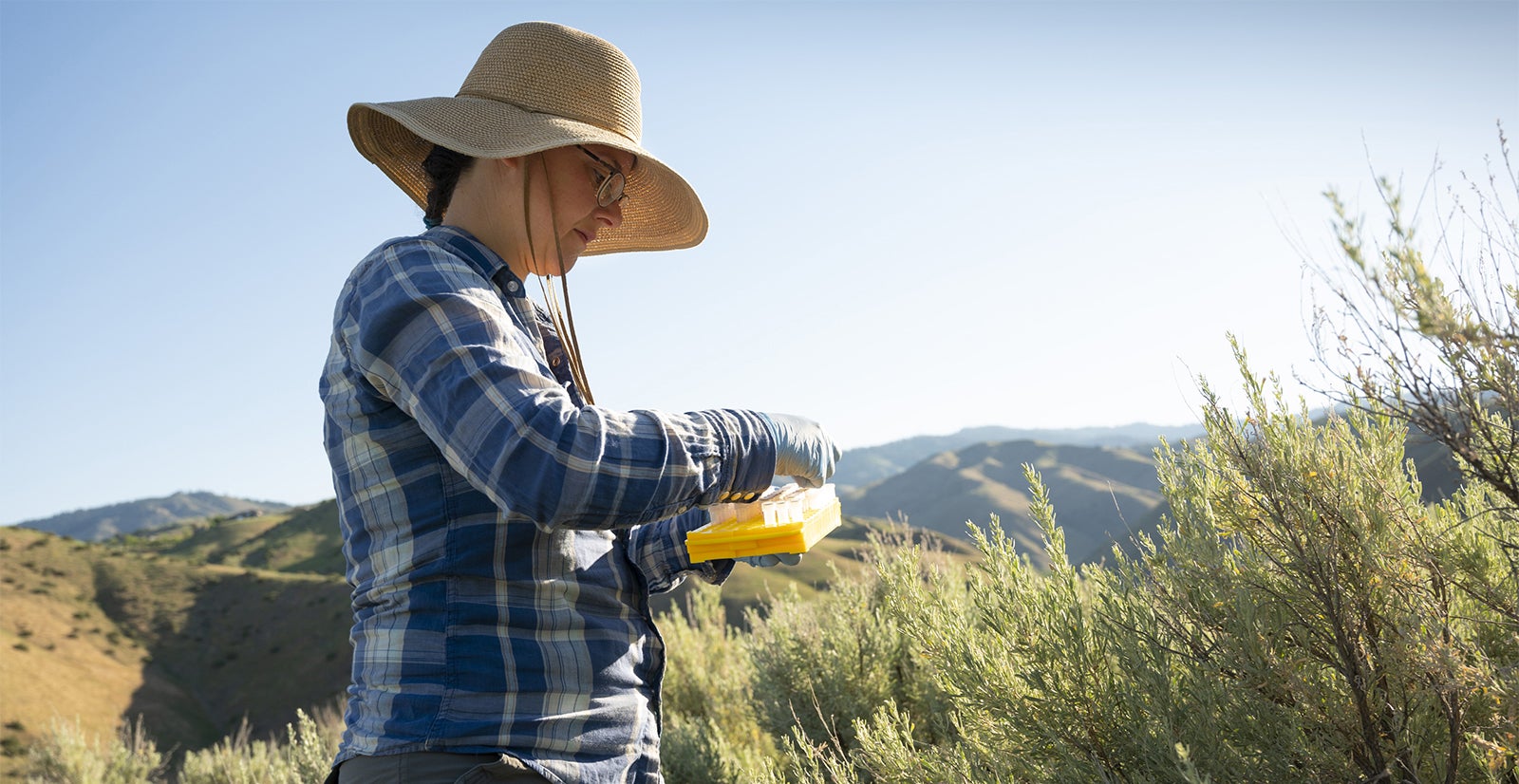
Leonora Bittleston’s research team looks for keys to preserving a symbol of the West
Walk by sagebrush. Smell that? It’s a chemical soup the plant produces, intended to kill or dissuade the growth of microbes and fungi. But some manage to live on sagebrush anyway.
Leonora Bittleston, an assistant professor in the Department of Biological Sciences, is studying why. She’s asking how these microorganisms may benefit sagebrush in hopes of saving the iconic plant and the complex Western ecosystem that depends on it.
“That smell we love comes from some pretty complex volatiles,” Bittleston said, including camphor (think mothballs) and terpenes, the compounds that make marijuana so pungent. “A lot of those things in the leaves are antimicrobial, and also toxic to animals.”
Few animals can eat sagebrush, but the ones that do, such as the declining populations of sage-grouse, the pygmy rabbit, and mule deer, depend on it.
“Sagebrush is the foundation species of sagebrush steppe – the biggest rangeland ecosystem in the United States,” Bittleston said. The sagebrush steppe stretches across 165 million acres of the American West, including in Idaho.
Sagebrush is declining because of fire and habitat degradation. At one time, ranchers poisoned the plant because they thought it interfered with grass for grazing.
“Then we realized it’s important for the ecosystem. It’s a nurse plant and helps other plants grow,” Bittleston said, including grasses. Sagebrush also provides shade and transports water and nutrients like nitrogen with its deep roots.
Establishing a baseline
The first step in Bittleston’s work is to identify what bacteria and fungi are present on sagebrush.
“There’s no existing characterization of the microbes on and in sagebrush leaves,” Bittleston said. “We need to know who’s there and understand more about what they might be doing.”
Each sagebrush leaf is a tiny world unto itself – what biologists call a microbiome. Bittleston’s team is focusing on a site near Dry Creek in the Boise Foothills. For more than a year researchers will collect leaves from all parts of sagebrush plants, during all seasons, and in all kinds of weather, to culture and sequence what’s living on – and in – the leaves.
Bittleston’s research is unique. Though a small number of researchers are studying sagebrush leaf microbes, to date, no studies have been published. Bittleston believes her study is the only one exploring how sagebrush microbial communities change over time.
Bittleston’s lab is also barcoding the bacteria found on sagebrush using DNA sequencing, learning that many are associated with extreme environments. “The bacteria are getting a lot of sun so they need to tolerate ultraviolet light,” she said. “They need to be able to tolerate salinity because the water dries up.” Consequently, the team is finding some Bacillus species that form spores to persist in harsh environments.
Students play key roles
“I was excited to learn more about how organismal interactions occurring at the microscopic level impact our macroscopic world,” said Rachel Capezza from Spokane, Washington. She’s in her first year at Boise State as a junior studying biology after earning an associate’s degree from the College of Western Idaho. “The icing on the cake for me was that all of this investigation was within the context of sagebrush, a shrub species I had come to know and love from my ecology and field biology work.”
Jacob Heil, a Ph.D. candidate in Boise State’s Ecology, Evolution, and Behavior program from Wichita, Kansas, said the work he’s doing with Bittleston is multi-faceted and challenging.
“This project has expanded my abilities in the lab and my understanding of the microbial and plant worlds,” he said.
Why it matters
Identifying microbial sagebrush colonizers may help sagebrush to grow and thrive, especially as climate change alters landscapes. Seeding and transplanting sagebrush to replenish the steppe hasn’t worked well so far. The microbial environment Bittleston and her team is researching may be the answer to the plant’s survival.
“If we can better understand the relationship between the sagebrush and its microbes we can better understand how restoration and management can be improved and have healthier sagebrush ecosystems,” Bittleston said.
For Capezza, the research goes beyond sagebrush itself.
“I’ve learned so much more about how microbes can drive plant health and the many implications that has for ecosystem functioning and, ultimately, public well-being,” Capezza said. “It’s only given me stronger conviction that we need scientists who are able to see how the small things are really the big things. This work is not only relevant, it’s crucial. And I want to be a part of it.”
In the field and in the lab
Bittleston believes her study is the only one exploring how sagebrush microbial communities change over time.
Idaho GEM3
Leonora Bittleston’s research is one of several GEM3 projects taking place at Boise State, University of Idaho, and Idaho State University. GEM3 (Genes by Environment, Modeling, Mechanisms, Mapping) is a $20 million statewide National Science Foundation EPSCoR (Established Program to Stimulate Competitive Research) initiative to discover how genetic mechanisms predict organisms’ adaptations to changing environments. The research will inform natural resource management. Twenty-four GEM3 projects are taking place at Boise State focusing on sagebrush, redband trout – both integral to western ecosystems – as well as diversity and workforce development.
